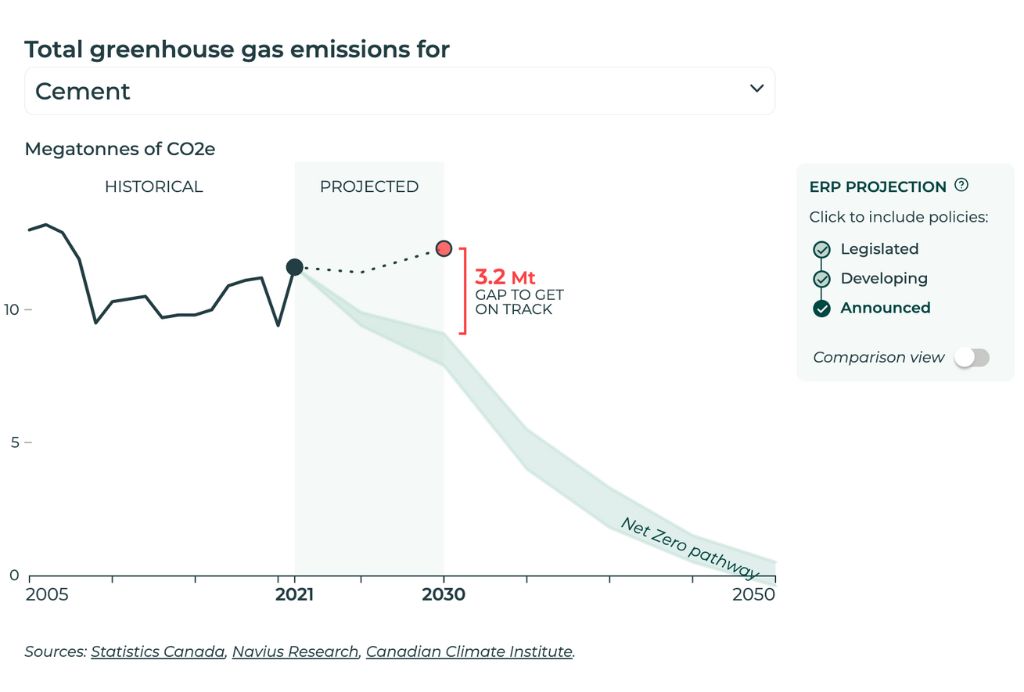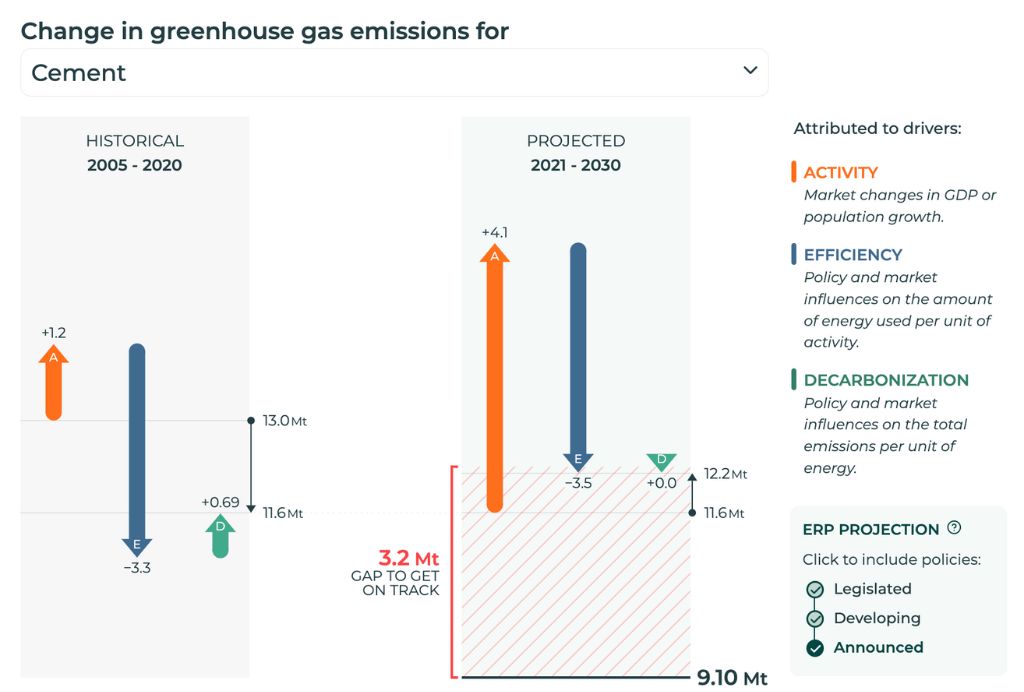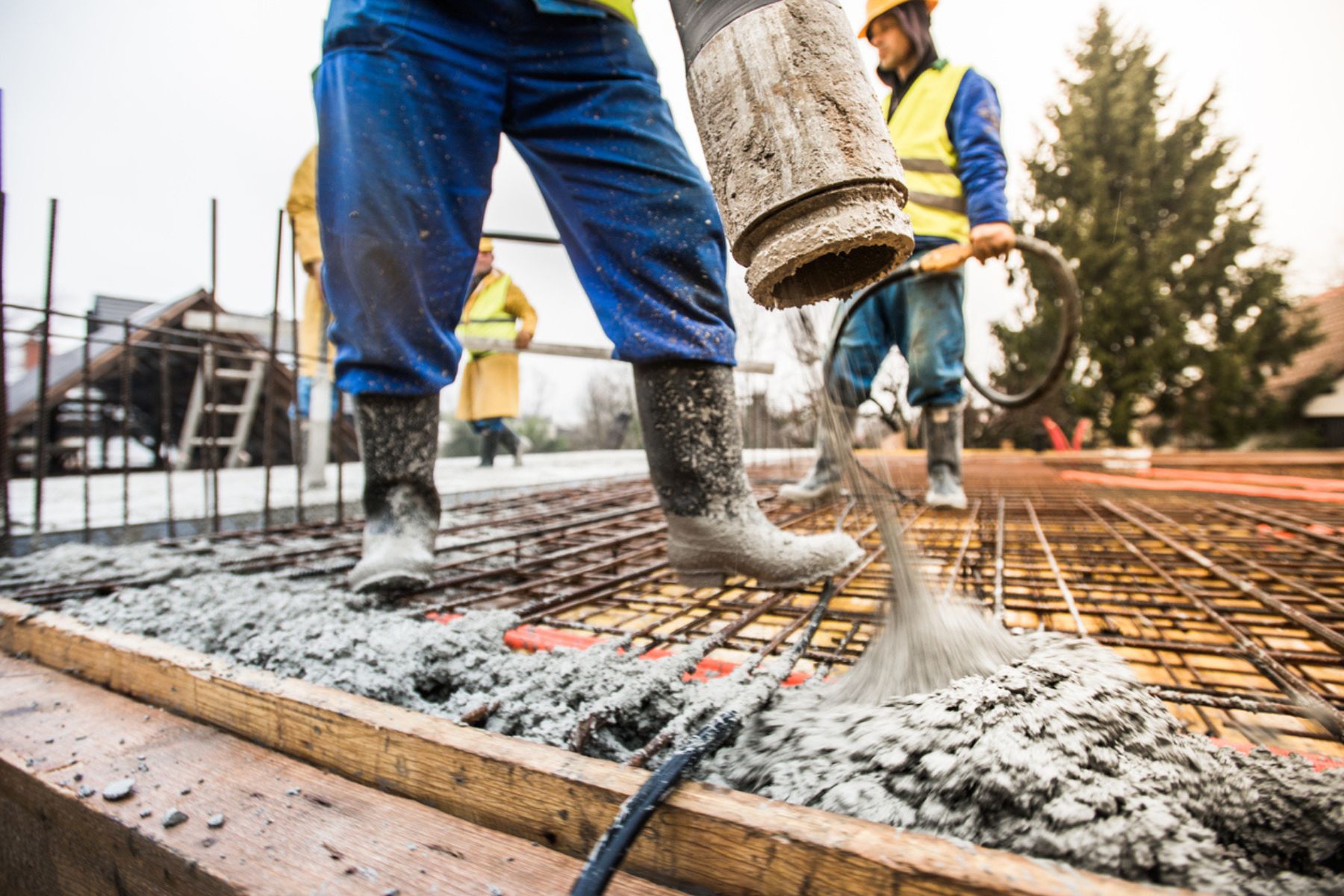Decarbonizing the cement sector is a challenge that will require a big effort and innovation from both industry and government.
It’s hard to picture a world without concrete—it’s the foundation for most of our urban and transport infrastructure. From buildings to bridges to sidewalks, concrete is all around us. But producing it currently comes with hefty emissions. As our analysis shows, the sector is not on a pathway in line with Canada’s 2030 emissions target (Figure 1).
While the terms are often used interchangeably, cement and concrete are not the same thing. Cement is actually an ingredient in concrete, along with sand, gravel, and water. But it’s the production of cement’s primary ingredient, clinker, made from intensely heated and ground limestone, that creates the bulk of greenhouse gas emissions in concrete production (This is why it’s usually the cement sector that’s the focus of emissions reduction efforts). Typically, 40 per cent of direct greenhouse gas emissions comes from the combustion of fuels like coal and petroleum coke, natural gas, and waste tires to convert limestone to clinker, the main component that gives concrete its structure—the remaining 60 per cent comes from the chemical reactions involved in that conversion.
Figure 1: Current and announced policies aren’t enough to get the cement sector on a net zero pathway

Breaking up is hard to do
Decoupling production from greenhouse gas emissions will be more difficult in the cement sector than in other industrial sectors due to the high share of emissions from the process of making Portland limestone cement—the most common type of cement. While there are options that could fully decarbonize the sector on the path to net zero by 2050 (like carbon capture), there are other options that can be implemented quickly to reduce emissions this decade; see the Roadmap to Net-Zero Carbon Concrete by 2050 for a detailed look at the opportunities.
A lot of fuel is needed to create intense heat in the cement kiln to change limestone into cement. As in all industries, producers in the cement sector need to minimize costs and therefore use the cheapest fuels available to generate heat—including coal, petroleum coke, natural gas, and waste tires. These fuels are good from a cost perspective, but not great when it comes to greenhouse gas emissions.
Increasingly biofuels are seen as an option to decarbonize a variety of sectors. However, heating cement kilns might not be the best use of biofuels, given their limited feedstocks and potentially more effective use in other sectors, like transportation. A better option to decarbonize cement production might be to introduce efficiency improvements that reduce the amount of clinker included in cement and, in turn, reduce the amount of emissions-generating fuel required for heating.
Binding materials other than clinker can be partially added to cement without significantly changing the physical properties of the final product. By-products from other industries have already been used to replace clinker, including fly ash from coal power generation and blast furnace slag from iron and steel manufacturing. While using these materials has been a win-win for industries that would have had to dispose of the waste anyways, both coal electricity generation and the use of blast furnaces in steel making are expected to decline in Canada, especially on the path to a net zero economy. One alternative is the replacement of some of the clinker currently used in cement with volcanic ash, calcined clay, and possibly increased ground limestone, which could cut emissions associated with the avoided clinker production. Not only can the product mix of cement be changed to reduce emissions, but carbon dioxide can also be injected into concrete to effectively sequester it, further reducing emissions. These efficiency improvements can be implemented quickly and drive significant decreases in some of the hardest-to-abate greenhouse gas emissions from cement production. As our analysis of Canada’s Emissions Reduction Plan shows, efficiency and other improvements to reduce the amount of energy per tonne of cement can continue over the next decade (Figure 2).
Figure 2: Efficiency improvements only offset expected growth from cement production emissions

But efficiency improvements only offset the increase in emissions expected from growth of the industry. For the deeper emissions reductions required to put the cement sector on a net zero pathway, it will need to capture the remaining greenhouse gas emissions being released from fuels and the clinker production process. Investing in carbon capture, utilisation, and storage (CCUS) can be an effective method for the cement industry to decarbonize beyond the efficiency measures above. But CCUS plants need to be rapidly installed to achieve broad implementation by 2030. The industry, both domestically and globally, needs to quickly move beyond feasibility studies to real-world testing at the production kiln scale. Canada can be a leader with this technology but only with experience and innovation.
WE BUILT THIS CITY
As the 440 Megatonnes Policy Tracker shows, there are many government policies that could go beyond energy efficiency to support CCUS implementation in the cement sector. The federal government is developing a Carbon Management Strategy and has put forward an Investment Tax Credit for CCUS covering 50 per cent of upfront installation costs (although clarity is needed to ensure carbon capture applied to cement kilns will be an approved use). Provincial governments have implemented or proposed policies on low-carbon fuels, funding carbon capture, and promoting energy efficiency that can all apply to cement production.
More broadly, the cement sector is covered either directly by a rising carbon tax or by some form of an Output-Based Pricing System. Both provide an incentive for production facilities to reduce their emissions.
On the demand side, governments need to ensure regulations and standards are in place to enable greater use of low-carbon cement in concrete applications. Ramping up testing of alternative cement mixes to ensure appropriate product performance and then updating building codes, with a focus on performance rather than rigid specifications, is a key measure to help reduce emissions. The federal government has committed to updating its model building codes and provincial governments should follow suit. Product testing and code development is an ideal area for cooperation between government, industry, and building trades. Governments can take this one step further and proactively buy low-carbon building materials for their projects.
Both the public and private sectors will need to make innovation a priority in how Canadian firms use and produce cement. The good news is that many of the enabling policies are already in place. Now governments and industry need to move quickly and leverage them to put the cement sector on a low-carbon pathway to 2030.
Brad Griffin is a 440 Megatonnes Advisor and the Executive Director of Simon Fraser University’s Canadian Energy and Emissions Data Centre.
